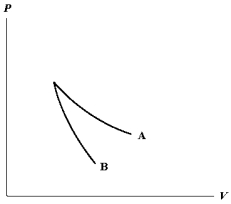Multiple Choice
The relation PV = nRT holds for all ideal gases. The additional relation PV holds for an adiabatic process. The figure below shows two curves: one is an adiabat and one is an isotherm. Each starts at the same pressure and volume. Which statement is correct? (Note: ' ' means 'is proportional to'.) 
A) Isotherm: ; Adiabat:
: A is both an isotherm and an adiabat.
B) Isotherm: ; Adiabat:
: B is an isotherm, A is an adiabat.
C) Isotherm: ; Adiabat: : A is an isotherm, B is an adiabat.
: A is an isotherm, B is an adiabat.
D) Isotherm:  ; Adiabat:
; Adiabat: : B is both an isotherm and an adiabat.
: B is both an isotherm and an adiabat.
E) cannot answer without additional information about the starting temperature.
Correct Answer:

Verified
Correct Answer:
Verified
Q6: During an adiabatic compression,a volume of
Q15: Assume 3.0 moles of a diatomic gas
Q22: The molar specific heat at constant
Q23: A container having a volume of
Q23: Air expands adiabatically (no heat in,no
Q24: According to kinetic theory, a typical gas
Q26: The average molecular translational kinetic energy
Q30: A 50-gram sample of dry ice
Q31: A molecule in a uniform ideal
Q32: Suppose a box contains about 5.0*